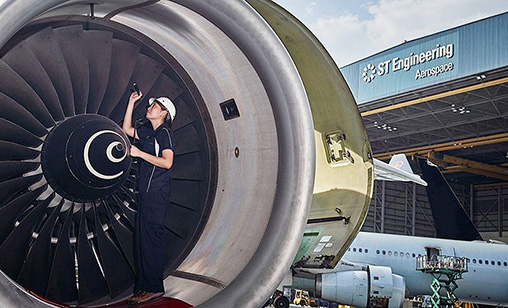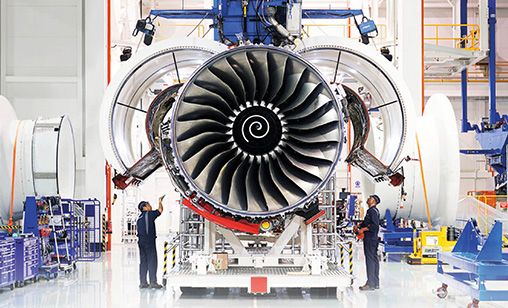Industry Insight Special Report
Aircraft MRO breaking revenue records
Supply chain issues and aircraft delivery delays may be dogging airline operations, but they are generating new revenue records for aircraft MROs. Associate editor and chief correspondent, Tom Ballantyne, reports.
August 1st 2025
An ageing global airline fleet that requires more servicing is contributing to a super cycle for the airline MRO market, a recent Oliver Wyman research paper reports. Read More » The sector is set to be worth US$119 billion in 2025, surpassing the previous record high, in 2019, by 12%. The average age of the global fleet, the consultancy said, has increased to 13.4 years this year from 12.1 years in 2024.
At an annual growth rate of 2.7%, Oliver Wyman forecasts the airline MRO sector will have a value of $156 billion in a decade. Apart from a plethora of older aircraft needing more regular MRO checks, additional factors will drive demand including unexpected durability issues necessitating earlier than anticipated maintenance visits.
 |
Additionally, each aircraft is putting in more flying hours to compensate for the shortfall in aircraft needed to match passenger demand. Increased aircraft utilization is projected to exceed 112 million flight hours a year by 2035, 39% more than 2024.
Oliver Wyman is not alone in forecasting robust growth for the sector. Alton Aviation Consultancy has written that in 2024 the global MRO spend was $124 billion, will increase to $127 billion this year and reach $153 billion in 2035 - annual growth of 1.9%.
“The combination of higher materials, cost escalation, labor cost inflation, higher aircraft utilization and fewer than expected airliner retirements contribute to strong long-term year-on-year MRO growth,” Alton said.
The Asia-Pacific will be the largest source of MRO demand, at 36% globally, followed by North America (20%) and Europe at around 20%, the consultancy said.
Within the industry, collectively there is no doubt one of the major factors feeding MRO growth are aircraft delivery delays. Last July, as an example, Airbus revealed it had approximately 60 commercial aircraft awaiting engine installations, commonly referred to as “gliders” in the industry.
The jets, mostly from the A320neo family, are completed in structure but remain grounded due to missing engines, a direct consequence of ongoing supply chain disruptions. The European planemaker confirmed the backlog in its latest financial update and noted delays from engine OEMs, Pratt & Whitney and CFM International, have held back a planned ramp up of aircraft output for full-year 2025.
Boeing is facing similar challenges. It’s long delayed B777-9 was expected to enter service in 2020. Certification issues and technical challenges have delayed it by at least six years. Entry into service is targeted for 2026.
As a result, airlines awaiting delivery of the new twin aisle have to continue operating older existing aircraft. In the region, B777 series customers include Cathay Pacific Airways. On August 6, the Hong Kong-based carrier announced it had added 14 more of the type to its order book, increasing its commitment to 35 of the new wide-body type.
Air India, All Nippon Airways, China Airlines, Korean Air and Singapore Airlines also have confirmed orders for the airliner.
Alton forecasts narrow-bodies will create the biggest demand for MRO, increasing their 55% market share to 65% in the next decade.
By category, engine MRO is predicted to be 50% of the entire MRO spend, followed by component MRO (21%), line maintenance (12%), air frame heavy maintenance (7%) and modifications (6%).
 |
New generation engines are 27% of engine overhaul volume today, but will skyrocket to around 77% of engine overhaul volume by 2035. Some new generation engines suffer from low time-on-wing performance, but this situation is expected to improve as programs mature, Alton said.
Modifications will be the fastest growing MRO segment, at 3.7% annual expansion in the next decade, driven by airlines intent on differentiating themselves from competitors. It is forecast they will invest in cabin interior modification/refurbishment programs and inflight connectivity installations.
Another problem for airlines is engine maintenance. General Electric (GE) and Rolls-Royce are reporting significant challenges in meeting demand for engine repairs. Wait times have surged 150% for modern engines and 35% for older models.
This situation is a result of ongoing supply chain disruptions, an increase in fleet utilization and component shortages.
There is little sign of an early resolution to many of these issues. Oliver Wyman said aircraft MRO is grappling with supply chain disruptions fed by the global pandemic, geopolitical tensions and raw material shortages.
“These disruptions have delayed availability of essential parts and components, leading to longer turnaround times and increasing operational costs. The industry’s reliance on global supply chains for parts and materials means any interruption can cause widespread delays in MRO activities,” the consultancy said.
GE Aerospace is investing more than US$1 billion to upgrade its engine repair shops to address these challenges and enhance repair capabilities. “As more companies invest in expanding capacity, the global MRO sector must adopt a more resilient and adaptive approach to its supply chain logistics,” analysts universally agree.
Integration of AI and automation will be critical for MRO providers if they are to remain competitive. AI-powered diagnostics identify issues difficult or time-consuming for human technicians to detect. Digital tracking systems deliver real-time updates on the status of repairs, improving transparency for clients.
In response to a shortage of skilled labour, MRO providers must focus on workforce development, particularly training and retaining the next generation of aviation technicians, engineers and managers in advanced technologies to create a culture that attracts young talent to the industry.
“As the global fleet size grows, the shortage will be exacerbated. An aging technician work force combined with a lack of interest in entering the field from younger talent threatens the industry’s ability to service increasing MRO demand and erodes knowledge and expertise. MROs face rising costs as they need to pay more to retain their existing workforce and/or attract recruits,” Alton said
For airlines, it is a business of catch up. Air passengers hit an all-time high of 4.9 billion in 2024 and will be well more than five billion this year.
Yet today the backlog of unfilled aircraft orders is more than 17,000 jets, its highest ever. Given current rates of production, these orders will take 14 years to clear, twice as long as airlines had to wait for deliveries pre-2019.
As a result, more airlines must fly older planes, pushing up the average age of the global fleet by almost a full year in 2024. It also is taking a toll on fuel efficiency, which benefits from the more efficient engine technology of new jets. The International Air Transport Association, has reported global fuel efficiency was unchanged in 2024, a significant departure from the 1.5% to 2% annual improvement typically realized as new aircraft enter airline fleets.
What is certain is when 6,000 plus attendees gather at Aviation Week Network MRO Asia-Pacific at the Singapore Expo and Convention Centre on September 16–18, it’s 25th year as the region’s leading gathering for the aviation MRO industry, there will be more than enough topics and challenges to discuss.